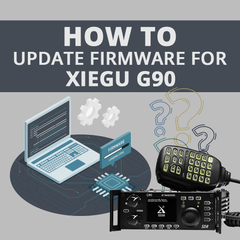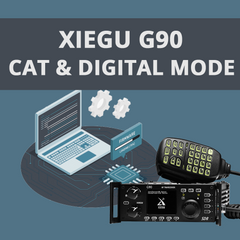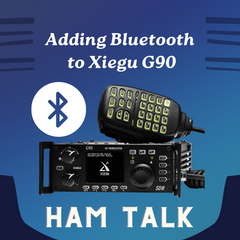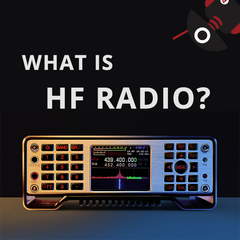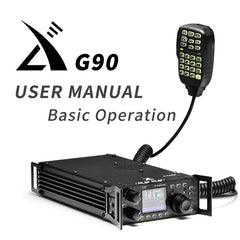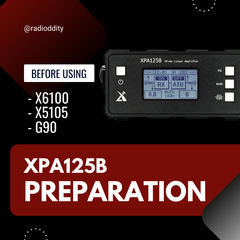◆ Detachable Display Unit —— The display unit and the radio body can be separated. This allows you to place the head remotely. What's more, the radio is very compact.
◆ Wide Range Auto Antenna Tuner —— Unlike other QRP radios, the G90 has a wide-range internal automatic antenna tuner so you can load up your favorite field antenna!
◆ Beautiful Color LCD Screen —— All vital operating information is clearly visible in daylight conditions. 48KHZ wide spectrum display with waterfall gives you excellent awareness of the signal conditions around you.
◆ Easy to Use —— Intelligently designed, the most commonly used functions are on hardware buttons. Next you can use the Quick Menu function to access often-used functions.
◆ Firmware Updates——We do provide firmware updates to enhance the functions of the radio – at no cost. You can easily update the firmware yourself.
◆ Warranty Note —— We provide a 18-month warranty on the Xiegu G90 (was 12
months before September 14, 2022). As usual, if you modify the radio's hardware, the warranty is void. (The warranty is void right after you remove any part of the radio case without the agreement of our support team.) Note any firmware bugs or any other software-related issues are not under warranty.
◆ Disclaimer: No License is required to purchase this radio, nor to Monitor (listen) to the many Amateur (Ham) Radio frequencies. However, an FCC License is required to Transmit (Talk) on Amateur Radio Frequencies in the USA. Please visit http://wireless.fcc.gov/services/amateur/licensing to learn more.
Note:
1. G90 Latest Firmware: V1.80 |
CLICK TO DOWNLOAD
2. 2023 Firmware Update Instruction |
CLICK TO LEARN
3. Radioddity Customers G90 FAQ |
CLICK TO LEARN
4. Xiegu G90 CAT and Digital Mode V1.0 |
CLICK TO LEARN
CLICK HERE to download the detailed user manual V4.2.3 provided by Radioddity.
The G90 is the first model of the new Xiegu G-series. It's a portable 20W HF 10-160 mtr. multimode transceiver. The G90 uses 24-bit digital architecture. It also includes an internal automatic antenna tuner. The G90 has excellent transmit and receive performance. It packs huge performance into a small portable package.
The G90 has a removable display head that can be separated from the main body and connected via a DB-9 cable (provided with the radio). Both the radio's control head firmware and main body operating firmware can be user-updated using separate connectors on the head and body. The programming cable is provided.
FW Update Note
Please update the display unit first then the base. Also please note you must choose the 1k option in the file transfer menu. In the beginning, you have to press the space bar very quickly or it won't go into program mode.

Detachable Display Unit
The detachable display design allows you to customize your installation.
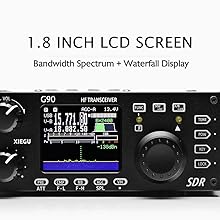
Color LCD Display Shows
±24khz bandwidth spectrum and waterfall. The sweep/refresh rate is very fast. The status of all functions are shown on the LCD display.

Convenient Side Interface
The G90 uses a standard 3.5mm stereo jack (3-pin) for connecting headphones. Also on the control head is a Firmware update port.

Multi-Function Mic
The microphone has two configurable and several dedicated function buttons.
Features
- Up to 20W of RF power
- High-performance RF front end giving superb selectivity
- Modes provided are USB/LSB/CW/CWR/AM/NFM
- 1.8-inch high brightness color TFT LCD screen
- ±24k bandwidth fast-scan spectrum display with waterfall
- Adjustable DSP band filters (CW mode can be as narrow as 50Hz)
- Detachable front panel/display head unit
- Built-in CW Decoder
- Built-in Antenna SWR scanner
- Built-in wide-range automatic antenna tuner
- Built-in mediumwave (AM broadcast) high-pass filter
- I/Q output for interfacing with a PC or adapter
NOTE
- FM mode is available.
- It's normal that G90 overheats if used for a long time.
- If you want to keep the power of G90 on 20W, the voltage must be in 13.8 V-15V.
If the voltage is 13.8V below, the power would not be guaranteed and the driving kinetic energy would not enough.
| # General Specifications | |
| Frequency receive | 0.5MHz-30MHz |
| Frequency transmit: | 1.8-2.0MHz | 3.5-4.0MHz* 5.330.5-5.405MHz | 7.0-7.3MHz* 10.1-10.15MHz | 14.0-14.35MHz 18.068-18.168MHz | 21.0-21.450MHz 24.89-24.99MHz | 28.0-29.7MHz |
| Operating modes: | USB/LSB/CW/CWR/AM/FM (*2) |
| Minimum step: | 10Hz |
| Antenna impedance: | 50Ω |
| Working temperature: | 0°C ~ +50°C |
| Frequency stability: | ±1.5ppm in the 10~60min after startup
@25°C: 1ppm/hour |
| Power supply voltage: | 10.5~16.5VDC, negative ground
(must be 13.8-15V if need 20W) |
| Current consumption: | Receive: 700mA@ Max
Transmit: 6A@ Max |
| Antenna socket: | SL16-K type, impedance 50Ω |
| Case size (mm): | 4.75 x 1.75 x 8.25inch | 12 x4.5 x21cm (case only)
5.5 x 2 x 9.8inch | 14 x 5.2 x 25cm (with handles) |
| Weight: | About 3.6lb | 1.63kg (main body) |
| # Transmitter | |
| RF output power:
(@ 13.8VDC) |
20W(SSB/CW/FM/AM) |
| Spurious suppression: | ≥50dB |
| Carrier suppression: | ≥40dB |
| Microphone impedance: | 200Ω ~10kΩ (600Ω in general) |
| # Receiver | |
| Circuit type: | Zero-IF (ZIF) direct conversion SDR |
| Neighboring channel suppression: | ≥60dB |
| Sideband suppression: | ≥60dB |
| Mirroring suppression: | 70dB |
| Sideband suppression: | 60dB |
| Audio output: | 0.5W (8Ω, ≤10% THD) |
| Audio output impedance: | 4~16Ω |
*Note:
1. The 80-meter or 3.5 MHz band is a band of radio frequencies allocated for amateur radio use, from 3.5 to 4.0 MHz in IARU Region 2 (consisting mostly of North and South America), and generally 3.5 to 3.8 or 3.9 MHz in Regions 1 and 3 (the rest of the world) respectively.
2. The 40-meter or 7-MHz band is an amateur radio frequency band, spanning 7.000-7.300 MHz in ITU Region 2, and 7.000-7.200 MHz in Regions 1 & 3.
| Sensitvity | SSB/CW/FM | AM |
| 0.5~1.79999MHz | / | 10uV |
| 1.8~1.9999MHz | 0.35uV | 10uV |
| 2.0~27.9999MHz | 0.25uV | 2uV |
| 28~30MHz | 0.25uV | 2uV |
(PRE=on,ATT=off,NB=off,NR=off,SSB/CW/AM = 10dB S/N,FM = 12dB SINAD)

Recommended Accessories (not included in the package)
1.
Xiegu CE-19 Expansion Port for easy PC connection
2.
Xiegu DE-19 Data Interface Expansion Adapter
3.
Radioddity G90-H1 Holder & Cooling Fan
4. Radioddity G90-H2 Stand
5.
Radioddity G90-H3 Portable Stand
6.
Radioddity PB3 Carrying Case
7. Xiegu XPA125B 100W Power Amplifier
8. Xiegu GSOC Controller Panadapter/Data Terminal
9. Xiegu GNR1 Digital Audio Noise Filter
10. Xiegu VG4
40m/20m/15m/10m 4-band Vertical Antenna
11.
Xiegu DH100 100W Portable Power Station
12.
Xiegu G90 Spare Parts Kit
13.
Radioddity HF-008 Portable 6M-80M Antenna
Package Content
1 x Xiegu G90 Transceiver
1 x Multi-function Microphone
1 x Firmware Cable
1 x Power Cable
1 x DB-9 Remote head cable
1 x Operation Manual
1 x Warranty Card
1 x Certificate
2 x Fixed Stud
1 x Hexagon Screwdriver
4 x Front and rear extension handles
Xiegu G90 Detailed Review
1 Year and 6 months Manufacturer's Warranty.
• This warranty from Radioddity covers all new items (except Xiegu brand)
purchased from radioddity.com. For purchases made
through other platforms like Amazon, eBay, and Walmart, we offer a 1-year
warranty period from the date of purchase. The specific warranty terms may vary
depending on the authorized dealer.
• This warranty cannot be transferred. You need to provide proof of purchase
from us or an authorized dealer to avail warranty service.
• For Xiegu brand items, we offer a 1.5-year warranty for the G90, X6100, and
X5105 models starting from September 14, 2022. All other models come with a
1-year warranty.
What Does This Limited Warranty Cover?
We warrant that the Products are free from defects in materials and workmanship
under normal use and use in accordance with the respective Product user manual,
during the Warranty Period. Please refer to the Instructions inside each package
for a description of proper use and care of the unit.
What Does This Limited Warranty Not Cover?
This limited warranty does not cover damages directly or indirectly arising or
resulting from or during:
(1) accident, misuse, abuse, vandalism or acts of God (including lightning and
other weather conditions)
(2) use with another product or other damage or loss suffered by the use or
combination of any other item
(3) improper or inadequate maintenance
(4) repairs by an unauthorized service technician
Open Box items are products that have damaged packaging or are otherwise not
suitable to be sold as new. All items are tested to be working by a member of
our team.
Open Box items come with a 6-month warranty instead of the standard 18 months
warranty and are not eligible for any warranty extension offered to new
products. We will not accept returns of Open Box items due to cosmetic damage or
other non-performance-related issues. All sales of Open Box items are final and
not eligible for a return or refund.
If for some reason the item is defective on arrival, please contact
If you are satisfied with our products and service, please kindly leave us a
positive product review. Any problem, be free to contact us
support@radioddity.com
We strive to answer all emails as quickly as possible, but due to high email
volume, it may take time for us to reply. Thanks in advance for your patience!
Order Processing
All orders are processed within 1-2 business days after we receive
your full payment, excluding weekends and holidays.
As soon as your order is ready, we’ll update the tracking number and send it to
you if you’re a Radioddity Member. We highly recommend that you register as a
Radioddity Member
here.
If the item you ordered is temporarily out of stock, our customer service team
will reach out to you. You can choose to wait until the item is back in stock or
cancel your order.
Please be aware that we have several distribution centers globally. Therefore,
your orders may be shipped from various locations including the United States,
Canada, Europe, or China, depending on the availability of the product in our
inventory.
Flat Shipping Rates
|
Country |
US |
EU |
Outside US & EU |
| Free when order amount ≥ $99.99 | Free when order amount ≥ $99.99 | Free when order amount ≥ $99.99 | |
|
Flat fee |
$9.99 |
$9.99 |
$9.99 |
|
Ship from |
➤ United States |
➤ Germany ➤ China |
➤ China |
| Handling time | 1-2 business days | 1-2 business days | 1-2 business days |
|
Delivery time |
5-7 business days |
5-7 business days |
7-15 business days |
Note:
1. Customs fee included for US & EU countries.
2. Please note that taxes will be applied to shipping rates. These taxes will be calculated and added to your total at checkout.
3. US Shipping does not include Alaska, Hawaii and Puerto Rico area. Please contact us for a detailed shipping fee to these areas.
4. For EU countries, please be aware that the listed product prices do not include VAT.
5. For shipping options to other countries, please visit our EXPANDED INTERNATIONAL SHIPPING page.
6. Please be aware that for outlet items, pre-orders, and open box items, the
shipping services and charges may vary.
How Do I Change The Shipping Address Or Cancel My Order
Contact support@radioddity.com (CLICK HERE) immediately if you need to change the shipping address or cancel your order. Please be advised that some orders are shipped very soon after placement and it will not always be possible to make changes to the shipping address and/or cancel the order.
Frequently Asked Questions
- 1. What forms of payment do you accept?
- 2. Why has my credit card payment failed?
- 3. How do I know if it is safe to shop with you?
- 4. Is there any discount for bulk/volume purchases?
- 5. Do you ship internationally?
- 6. How can I contact Radioddity.com for additional assistance?
- 7. How are warranties handled?
- 8. Why didn't I receive an order confirmation email after my PayPal payment is completed?
- 9. How do I change the shipping address or cancel my order?
- 10. What does Radioddity.com charge for shipping order and how long will it be before I receive my order?
- 11. Do you ship to PO boxes or Military APO/FPO addresses?
- 12. Why am I unable to track my order?
- 13. Taxes, Customs, & Duties
- 14. How do I return products if I am unsatisfied?
- 15. What do I do if I received the wrong item?
- 16. How do I return defective items?
- 17. When will a replacement be sent?
- 18. How long does it take for me to get a refund?
1. What forms of payment do you accept?
Radioddity.com currently accepts PayPal* or credit card for all orders.
*When purchasing with PayPal, your shipping address will automatically default to the address on file with PayPal, regardless of the shipping address you enter on your Radioddity.com order.
2. Why has my credit card payment failed?
Payment with a credit card may fail because of bank authorization and fraud prevention systems. If you are having trouble making a payment via Credit Card, you may contact your card issuing bank or PayPal directly. Here are PayPal's phone numbers:
+1-888-221-1161 (US & Canada Toll Free) +1-888-215-5506 (US & Canada Toll Free)
+1-402-935-7733 (International) +1-402-935-2050 (International)
3. How do I know if it is safe to shop with you?
Radioddity.com takes great pride in offering a safe and secure online shopping experience. We also respect your privacy and we're committed to protecting it.
4. Is there any discount for bulk/volume purchases?
Radioddity does provide discounts for some bulk/volume purchases. Please email our customer service for more details.
5. Do you ship internationally?
Yes, we do! We ship to US & EU countries. For some products, we ship to CA.
6. How can I contact Radioddity.com for additional assistance?
Email Customer service:
please email us via support@radioddity.com, and we will respond to your email as quickly as possible, usually within 24-48 hours.
7. How are warranties handled?
Repairs on defective merchandise are handled by the manufacturers and not by Radioddity unless otherwise indicated. If any item arrives damaged due to shipping, immediately contact the courier. Keep all shipping materials and contact us immediately.
8. Why didn't I receive an order confirmation email after my PayPal payment is completed?
We send a confirmation email to your primary PayPal email address or the e-mail address you have specified if you used the "PayPal Express Checkout" method. Make sure that you have a Radioddity account registered under your PayPal account's primary e-mail address.
In rare circumstances, a technical bug confirmed by PayPal can get in the way. If you do not receive any information at all, and your order does not appear in your Radioddity account, please contact us and send us your order details.
9. How do I change the shipping address or cancel my order?
Please contact customer service immediately if you need to change the shipping address or cancel your order. Please be advised that some orders are shipped very soon after payment and it will not always be possible to make changes to the shipping address and/or cancel the order.
10. What does Radioddity.com charge for shipping order and how long will it be before I receive my order?
Please CLICK HERE to
learn about our shipping policy.
11. Do you ship to PO boxes or Military APO/FPO addresses?
Only USPS can ship to both PO Boxes and Military APO/FPO addresses. The items have to be less than 2kg. Please allow additional time for orders to be shipped to these addresses. Express shipping cannot be sent to both PO Boxes and Military APO/FPO addresses.
12. Why am I unable to track my order?
It can sometimes take 24-48 hours or so for tracking information to update once an order has shipped from our warehouse.
Occasionally, a package may not receive the proper origin and transit scans while on its journey to you, so neither us nor express is able to track the exact location of the package in transit.
Please email us if you do not receive your order by the end of the quoted time frame. Please note that orders shipping via UPS can be delivered as late as 9:00 pm local time in some areas.
13. Taxes, Customs, & Duties
If the package is checked by your country's customs office when the item arrives in your country, most websites are declaring that you are responsible for import duties, tariffs, and taxes. However, Radioddity will be happy to go fifty-fifty with customers. Quality customer service is our highest value and we try our best to reduce our customer’s loss.
14. How do I return products if I am unsatisfied?
Please CLICK HERE to
learn about our return policy.
15. What do I do if received the wrong item?
Return the wrong item. If the item you received is completely different from the one you ordered, please contact our Customer Service with photos or videos of the different product. If a return is necessary, replacement plus return shipping cost will be issued to you on receiving the returned product. Or if you decide to keep it, we will offer a 10% discount for buying it.
16. How do I return defective items?
If your product turns out to be a defective one with physical damage within 30 days from the initial receiving date. You can mail the item back in the original package without any wear and tear for a free replacement. However, you will need to provide photos and videos showing the defect(s) of the product.
*NOTE: We strongly recommend obtaining and saving your return tracking number until you are notified that we have completed your refund.*
17. When will a replacement be sent?
Replacements are treated the same way as that of new orders -- they typically arrive in 10 to 13 days. If a product needs to be returned for replacement, the replacement is sent after receiving the returned item.
18. How long does it take for me to get a refund?
It may take 1 or 2 weeks for your return to reach our warehouse. Once it is received and inspected (usually within 72 hours of arrival) your refund will be processed and automatically applied to your credit card or original method of payment within 2 days. Please note that depending on your credit card company, it may take additional 2-10 business days after your credit is applied for it to post to your account.



































